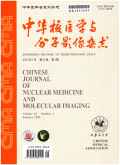18F-FDG PET/CT影像组学对滤泡性淋巴瘤BCL-2/IgH融合基因表达状态的预测价值
Predictive value of 18F-FDG PET/CT radiomics for BCL-2/IgH fusion gene expression status in follicular lymphoma
摘要目的:探究 18F-FDG PET/CT影像组学在预测滤泡性淋巴瘤(FL)患者B细胞淋巴瘤-2(BCL-2)/免疫球蛋白重链(IgH)融合基因表达状态的临床应用价值。 方法:回顾性分析河南省肿瘤医院2016年1月至2023年8月接受 18F-FDG PET/CT检查的90例FL患者[男46例、女44例,年龄(48.7±10.5)岁]的临床和影像学资料。根据BCL-2/IgH表达状态分为阳性组和阴性组。将患者以7∶3的比例随机分为训练集( n=62)和验证集( n=28),使用LIFEx 7.3.11软件提取PET和CT影像组学特征,采用最小绝对收缩和选择算子(LASSO)算法和十折交叉验证进行特征筛选,并构建PET组学模型、CT组学模型。通过单因素和多因素分析筛选临床特征,构建临床模型。最后将影像组学特征与临床特征结合建立联合模型。使用ROC曲线及AUC评估模型的预测性能,采用Delong检验比较AUC的差异。 结果:经特征选择,共选出3个PET组学特征、3个CT组学特征及2个临床特征,分别进行模型的构建。临床资料多因素分析显示,病理分级[比值比( OR)=0.201,95% CI:0.052~0.699, P=0.014]和最大病灶最大径(D max)( OR=1.033,95% CI:1.009~1.065, P=0.017)与BCL-2/IgH表达状态有关。在训练集中,临床模型、PET组学模型、CT组学模型和联合模型的AUC分别为0.84、0.80、0.80和0.91;在验证集中,4种模型的AUC分别为0.55、0.61、0.66和0.71。联合模型在训练集、验证集中的AUC有高于其他3种模型的趋势( z值:0.50~1.71, P值:0.087~0.620)。 结论:基于PET/CT影像组学联合临床特征预测BCL-2/IgH融合基因表达状态具有一定的价值。
更多相关知识
abstractsObjective:To explore the clinical application value of 18F-FDG PET/CT radiomics in predicting B-cell lymphoma-2 (BCL-2)/immunoglobulin heavy chain (IgH) fusion gene expression status in follicular lymphoma (FL) patients. Methods:A retrospective analysis was conducted on the clinical and imaging data of 90 FL patients (46 males and 44 females, age (48.7±10.5) years) who underwent 18F-FDG PET/CT examinations at Henan Cancer Hospital from January 2016 to August 2023. According to the expression status, patients were divided into positive group and negative group. Patients were randomly divided into training set ( n=62) and validation set ( n=28) at a ratio of 7∶3. PET and CT radiomics features were extracted by LIFEx 7.3.11 software. After using least absolute shrinkage and selection operator (LASSO) regression and ten-fold cross-validation for feature selection, PET and CT radiomics models were constructed. Univariate and multivariate analyses were used to select important clinical features and construct clinical model. Finally, a combined model was established by combining the radiomics features with clinical features. ROC curve and AUC were used to evaluate the predictive performance of models, and Delong test was used to compare the differences in AUCs. Results:After features selection, a total of 3 PET radiomics features, 3 CT radiomics features and 2 clinical features were selected for the construction of radiomics model and clinical model respectively. Multivariate analysis of clinical data showed that pathological grade (odds ratio ( OR)=0.201, 95% CI: 0.052-0.699, P=0.014) and maximum diameter of the maximum lesion (D max) ( OR=1.033, 95% CI: 1.009-1.065, P=0.017) were associated with BCL-2/IgH expression status. In the training set, the AUCs of clinical model, PET radiomics model, CT radiomics model and combined model were 0.84, 0.80, 0.80 and 0.91 respectively. In the validation set, the AUCs of the four models were 0.55, 0.61, 0.66 and 0.71 respectively. The combined model exhibited a trend toward higher in AUC than other three models in both the training and validation sets ( z values: 0.50-1.71, P values: 0.087-0.620). Conclusion:It is valuable to predict BCL-2/IgH fusion gene expression status based on PET/CT radiomics combined with clinical features.
More相关知识
- 浏览0
- 被引0
- 下载0


相似文献
- 中文期刊
- 外文期刊
- 学位论文
- 会议论文



 换一批
换一批 换一批
换一批



